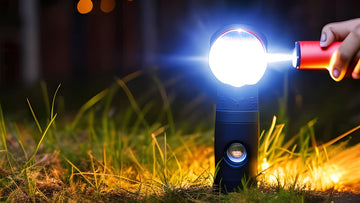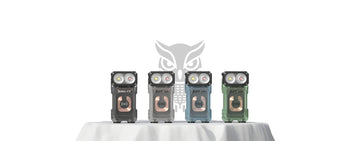
A flashlight, also known as a torch, is a portable handheld device that emits light when turned on. Typically used for illumination in the absence of natural or artificial light sources, flashlights are incredibly versatile tools. While they are primarily designed for providing light, it's worth exploring whether these handy devices have the potential to start fires.
Additionally, bulbs in flashlights generate heat as they emit light. Incandescent bulbs, for instance, produce considerable amounts of heat, increasing the risk of fire if the heat is not adequately dissipated. On the other hand, light-emitting diode (LED) bulbs generate less heat and are more efficient in terms of heat dissipation, reducing the likelihood of fire incidents.
Furthermore, these modifications can impact the overall safety of the flashlight. Altering the circuits or using batteries with higher voltage can exceed the device's intended capacity, compromising its ability to handle the increased power. This not only increases the risk of overheating but also endangers the user's safety. It is crucial to understand that flashlight modifications should only be done within the guidelines provided by the manufacturer to ensure proper functioning and minimize fire hazards.
Another aspect to consider is the use of flammable materials in flashlight customization. Some individuals may opt for decorative modifications that involve adding flammable substances, such as adhesives, paints, or other coatings. These materials can increase the risk of fire, particularly if they come into contact with the heat generated by the flashlight during operation. It is essential to exercise caution and avoid using flammable substances in flashlight customization to prevent potential fire incidents.
Accidental ignition sources should also be considered. Improper storage of flashlights, particularly alongside flammable substances or materials, can create a fire hazard. Inadvertent contact between the lens of the flashlight and highly flammable liquids or gases can result in ignition. Additionally, when using flashlights with adjustable focus, concentrated light beams can generate enough heat to ignite certain flammable materials if they come into direct contact.
When it comes to flashlight modifications, it is essential to prioritize responsible practices. Adhering to the manufacturer's specifications and guidelines ensures that the modifications are within the device's intended capabilities. Unauthorized alterations, particularly those that increase power output beyond the flashlight's designed limits, should be avoided to prevent overheating, short circuits, and fire risks.
While flashlights are primarily designed for providing illumination, it is important to be aware of the potential fire hazards they may pose. Understanding the components of flashlights and their associated risks, as well as the impact of modifications and unique circumstances, allows users to exercise caution and minimize fire incidents.
By following battery safety measures and refraining from unauthorized modifications, individuals can enjoy the functionality and convenience of flashlights without compromising their safety. Ultimately, responsible and informed use of flashlights ensures their effectiveness as tools while mitigating the risk of fire incidents.
The Science Behind Fire
Before delving into the subject matter, it's essential to understand the science behind fire. Fires require three crucial components, known as the fire triangle: fuel, oxygen, and heat. These elements must come together in specific proportions for ignition and the sustained burning of materials. Temperature also plays a pivotal role in initiating and perpetuating fires, as certain substances have different ignition points.Flashlight Components and Fire Hazards
To assess the fire-starting potential of flashlights, we must examine their various components and the associated fire hazards they pose. The power source, usually batteries, can be a significant concern. Certain battery types, such as lithium-ion batteries, have been known to cause thermal runaway, leading to fires or explosions. Understanding the risks associated with different types of batteries is vital for assessing the fire hazard potential of a flashlight.Additionally, bulbs in flashlights generate heat as they emit light. Incandescent bulbs, for instance, produce considerable amounts of heat, increasing the risk of fire if the heat is not adequately dissipated. On the other hand, light-emitting diode (LED) bulbs generate less heat and are more efficient in terms of heat dissipation, reducing the likelihood of fire incidents.
Flashlight Modification and Fire Risks
While flashlights are generally designed to operate within specific parameters, some individuals may choose to modify their devices to increase their power output. This can involve customizing the flashlight's circuits or using more powerful batteries. However, these modifications can introduce significant fire risks. The increased power output may lead to overheating, which can result in short circuits and potential fires.Furthermore, these modifications can impact the overall safety of the flashlight. Altering the circuits or using batteries with higher voltage can exceed the device's intended capacity, compromising its ability to handle the increased power. This not only increases the risk of overheating but also endangers the user's safety. It is crucial to understand that flashlight modifications should only be done within the guidelines provided by the manufacturer to ensure proper functioning and minimize fire hazards.
Another aspect to consider is the use of flammable materials in flashlight customization. Some individuals may opt for decorative modifications that involve adding flammable substances, such as adhesives, paints, or other coatings. These materials can increase the risk of fire, particularly if they come into contact with the heat generated by the flashlight during operation. It is essential to exercise caution and avoid using flammable substances in flashlight customization to prevent potential fire incidents.
Unique Circumstances Where a Flashlight Can Start a Fire
While flashlights, under normal circumstances, do not possess inherent fire-starting capabilities, certain unique circumstances can increase the likelihood of fire incidents. Extreme environmental conditions play a significant role in this regard. For example, if the surroundings are highly flammable, such as in areas with dry grass or forests prone to wildfires, a flashlight's concentrated beam of light can potentially ignite the combustible materials.Accidental ignition sources should also be considered. Improper storage of flashlights, particularly alongside flammable substances or materials, can create a fire hazard. Inadvertent contact between the lens of the flashlight and highly flammable liquids or gases can result in ignition. Additionally, when using flashlights with adjustable focus, concentrated light beams can generate enough heat to ignite certain flammable materials if they come into direct contact.
Precautions to Prevent Flashlight-Related Fires
To minimize the risk of fire incidents associated with flashlights, it is crucial to follow specific precautions and safety measures. Firstly, proper battery safety practices should be observed. This includes storing batteries in appropriate conditions, such as cool and dry environments, and avoiding exposure to extreme temperatures. Regular inspections of batteries for any signs of damage or leakage should also be conducted, and damaged batteries should be replaced promptly to prevent potential fire hazards.When it comes to flashlight modifications, it is essential to prioritize responsible practices. Adhering to the manufacturer's specifications and guidelines ensures that the modifications are within the device's intended capabilities. Unauthorized alterations, particularly those that increase power output beyond the flashlight's designed limits, should be avoided to prevent overheating, short circuits, and fire risks.
While flashlights are primarily designed for providing illumination, it is important to be aware of the potential fire hazards they may pose. Understanding the components of flashlights and their associated risks, as well as the impact of modifications and unique circumstances, allows users to exercise caution and minimize fire incidents.
By following battery safety measures and refraining from unauthorized modifications, individuals can enjoy the functionality and convenience of flashlights without compromising their safety. Ultimately, responsible and informed use of flashlights ensures their effectiveness as tools while mitigating the risk of fire incidents.
Related Articles




